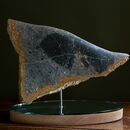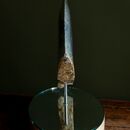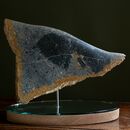tropical fish
A piece developed from the colours, textures and shape of the original stone found in the Purbeck quarry. The essence of a Tropical fish is captured primarily through the simple top curve, fine edge line and contrasting blues, greens and browns of the marble. The final piece has a delicacy of form whilst exhibiting a quiet presence.
Material; Purbeck marble
Dimensions HWD; 42x55x25cm
March 2023
Price; £1800
Purbeck marble is in fact a limestone formed 140 to 145 million years ago (the Early Cretaceous period) and called a “marble” because it can be worked to a highly polished finish. Its formed entirely of river snail shells (Viviparus) that collected in lagoonal beds on the Jurassic coast of Britain covering large parts of the Purbeck peninsula to a depth of just over 1m thick. The River Snail as a species is still around today! Over millions of years the shells have fossilized (absorbed minerals) and turned to stone.
The Romans quarried and worked the stone for its colour and high polish and its been used in virtually every Cathedral in Southern England as a decorative stone. It was also used in The Kings table used by Henry VIII.
Material; Purbeck marble
Dimensions HWD; 42x55x25cm
March 2023
Price; £1800
Purbeck marble is in fact a limestone formed 140 to 145 million years ago (the Early Cretaceous period) and called a “marble” because it can be worked to a highly polished finish. Its formed entirely of river snail shells (Viviparus) that collected in lagoonal beds on the Jurassic coast of Britain covering large parts of the Purbeck peninsula to a depth of just over 1m thick. The River Snail as a species is still around today! Over millions of years the shells have fossilized (absorbed minerals) and turned to stone.
The Romans quarried and worked the stone for its colour and high polish and its been used in virtually every Cathedral in Southern England as a decorative stone. It was also used in The Kings table used by Henry VIII.










